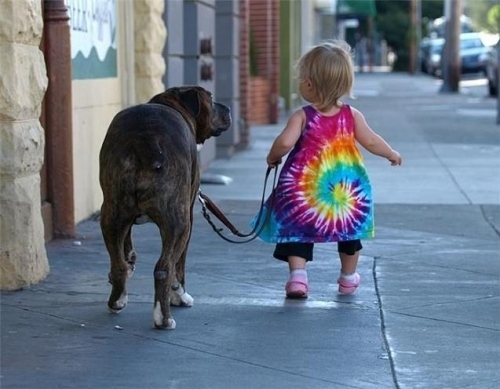If you’ve ever had to pick up and carry a tired child through the mall, you know that walking sometimes tuckers out the toddlers. Now scientists think they know why. The results appear in the Journal of Experimental Biology.
假如你曾经带着一个精疲力尽的小朋友逛超市,你就会知道什么是“举步维艰”。科学家称他们得知了其中的缘由。研究结果刊登在实验生物周刊上。
 Larger animals tend to use less energy per gram of body mass than smaller ones do, even at rest. But what happens when they’re in motion? Researchers recruited walkers of different ages and sizes, from a three-foot-tall kindergartner to a six-foot adult. While the subjects logged miles on the treadmill, the scientists measured their stride and metabolism.
Larger animals tend to use less energy per gram of body mass than smaller ones do, even at rest. But what happens when they’re in motion? Researchers recruited walkers of different ages and sizes, from a three-foot-tall kindergartner to a six-foot adult. While the subjects logged miles on the treadmill, the scientists measured their stride and metabolism.
体格庞大的动物与娇小的动物相比,即使在休息的过程中,也会消耗更少的能量。但是,他们在运动过程中又如何呢?研究人员征集了不同年龄不同身材的实验对象,从3英尺高的小朋友到6英尺的成年人。实验对象利用踏步机记录所走的长度,科学家则测量他们的步幅长度以及新陈代谢的程度。
And they found that people pretty much walk the same way, regardless of their stature. If you scaled a five-year-old up to be six-and-a-half feet tall, the giant child would lope along just like a similarly sized adult.
科学家发现,无论研究对象身高多少,他们走路的方式是一样的。假如将一个5岁的孩子放大到6.5英尺高,放大后的的孩子可能就会像个成年人那样行走。
What’s more, walkers of all heights use the same amount of energy per step. That means that big people don’t conserve energy by strolling in a more economical style. They expend less energy because—just as you may have always suspected—they simply need fewer strides to cover the same ground. Which means that for some people a walk in the park ain’t necessarily a walk in the park.
而且,不同身高的散步者每一步所消耗的能量是一样的。这就意味着身材高大的人不会因此而节省能量。他们消耗的能量少只是因为他们走相同的长度迈了更少的步子。这就意味着対于一些人来说,在公园里散步未必是一次散步。
来源:可可英语 http://www.kekenet.com/hangye/201201/167965.shtml Larger animals tend to use less energy per gram of body mass than smaller ones do, even at rest. But what happens when they’re in motion? Researchers recruited walkers of different ages and sizes, from a three-foot-tall kindergartner to a six-foot adult. While the subjects logged miles on the treadmill, the scientists measured their stride and metabolism.
Larger animals tend to use less energy per gram of body mass than smaller ones do, even at rest. But what happens when they’re in motion? Researchers recruited walkers of different ages and sizes, from a three-foot-tall kindergartner to a six-foot adult. While the subjects logged miles on the treadmill, the scientists measured their stride and metabolism.










